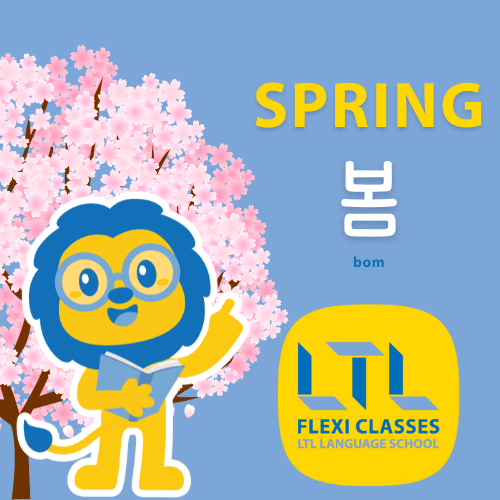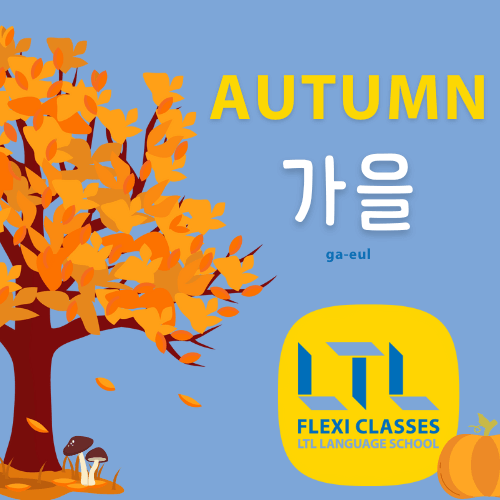A Traveller's Guide to Weather in South Korea | Best Times to Travel & More
Weather in South Korea | Plan Ahead

Given the size of the country the weather in South Korea is easy to understand and divides nicely into four seasons, making it very easy to make travel plans.
In this very straight forward article we will break down South Korea by seasons, and further below answer some frequently asked questions such as what is the best month to travel in South Korea, or what you need to know before arriving.
If you’re interested in one season in particular make sure to jump to the relevant section 👇
Weather in South Korea | Spring
Weather in South Korea | Summer
Weather in South Korea | Autumn
Weather in South Korea | Winter
Weather in South Korea | City by city
Weather in South Korea | Things you should know
Weather in South Korea | Essential vocabulary
First though, an important word we should learn:
Weather in Korean is 날씨 nalssi
Head to the end for more weather based vocabulary
Weather Report | Spring in South Korea

Spring in South Korea lasts from mid-March to June, and is the most popular time of year for tourists to come visit the country.
Temperatures are getting warmer, cherry blossoms are in full bloom and after a very cold winter people are getting out and about again, with many events, festivals and activities organised everywhere.
|| What to wear?
The weather in South Korean is still chilly in March/April so make sure to pack a jacket and if you get cold easily, a scarf as well.
It’s not time to bring your fave t-shirts.
It’d be better to bring long sleeved shirts instead.
Regarding footwear, it is too early for sandals, you’ll have to wear your trainers a little bit longer.
|| What to do?
Spring in South Korea is the perfect time to hike and discover the beautiful hills and mountains the country has to offer, especially in some of the National Parks.
Cherry blossoms will of course be blooming, so make sure to visit the popular sightseeing spots where you’ll stay.
As mentioned earlier many festivals and activities are organised this time of year, such as:
- Jeju Canola Festival | 제주 유채꽃축제
- Gurye Sansuyu Festival | 구례산수유꽃축제
- Gwangyang Maehwa Festival | 광양매화축제
- Jinhae Cherry Blossom Festival | 진해군항제
TOP TIP | As spring is considered the best time to visit South Korea, keep in mind in your travel plans that touristic places might be more crowded at that time.
Weather Report | Summer in South Korea

Summer in South Korea is short and lasts only from July to August.
The temperature averages 30°C which is not too tough to handle in itself, however summers in South Korea are very rainy, bringing the humidity to very high levels.
As in many other Asian countries at this period of time it is monsoon season, so it is not a wise idea to come and visit South Korea in summer if you’re mainly planning outdoor activities or touristic sightseeing.
|| What to wear?
Pack light and comfortable clothes, but also a light jacket for some chilly nights.
As it rains so much we advise taking shoes that can dry quickly, or a nice comfortable pair of sandals that don’t mind being under water.
You’ll find plenty of umbrellas wherever you go, so don’t bother with packing one unless it is a small retractable one.
|| What to do?
Just like Spring, many festivals (especially music and water themed) are organised in Summer in South Korea so you definitely should check one out.
Regarding activities, water parks are a must-go and camping is super popular!
The country also boasts beautiful beaches, so make sure to visit a coastal city such a Busan or Yeosu.
Weather Report | Autumn in South Korea

Autumn in South Korea lasts from September to November, and is another great time to visit the country.
The warmth of summer slowly makes way for cooler temperatures and it rains considerably less, allowing for the perfect condition for tourist activities.
In South Korea the four seasons are very distinct so you’ll quickly notice the change of colours and the red-ish leaves slowly falling everywhere.
|| What to wear?
No need for a warm jacket or thick scarves just yet, if you’re coming right after summer you’ll still need t-shirts and shorts as the temperature averages 21°C.
Bring a light jacket for the occasional rainy day and closed shoes if you’re planning to walk a lot as you visit.
If you’re visiting near the end of autumn, then pack extra layers as temperatures will soon drop below 10° as winter is coming.
|| What to do?
As you nay realise by now, one of the best activities to do in South Korea is hiking!
No matter where you go, you’ll enjoy a beautiful scenery or bright red, orange and yellow leaves that cherry blossoms in spring cannot compete with.
Chuseok, one of the most important holidays in South Korea takes place in autumn so you’ll definitely be able to take part in some related activities.
Autumn is the best season to do whatever activities you wish as the weather and landscape allows for pretty much everything. Enjoy!

Chuseok in South Korea | Mid-Autumn Festival Explained
What is Chuseok? Want to know more about the Korean Thanksgiving? Find out what Koreans do during this day, what they eat, and when the festivities are!
Weather Report | Winter in South Korea

Winter in South Korea is long and dry, lasting from December to March, reaching freezing temperatures as low as -20°C in the North.
The coldest months are January and February, where snow will be everywhere as it usually starts falling mid-December.
Although very snowy, especially in the northern regions, winter in South Korea is very sunny, but the snow doesn’t melt.
|| What to wear?
Boots, warm socks, sweaters, leggings or any type of insulated clothing you have.
You NEED to prepared for the cold! South Korean winters are not forgiving. Don’t take it lightly!
|| What to do?
If you like winter sports, you’ll find several ski resorts to go skiing or snowboarding, but you can easily enjoy the snowy scenery anywhere you go.
TOP TIP || They are especially beautiful in palaces and temples.
Do you prefer ice-skating? That’s an activity you can do both outdoors and indoors (such as at Lotte World in Seoul).
You can even go ice-fishing!
Seollal, one of the most important holidays in South Korea generally occurs in January and February, so you’ll have plenty of time to enjoy the celebrations.

Seollal 설날 // Korean New Year Explained (2025)
Seollal 설날 is the biggest and most important public holiday in South Korea. Find out what Koreans do on this day, when it falls, and learn some vocabulary!
Weather in South Korea | City by City
Let’s have a look in more detail at the most touristic places in South Korea and the respective weather conditions you can expect.
Weather in SEOUL
As you probably know already Seoul is the capital city of South Korea and the biggest metropolis of the country.
Did you know that half of South Korea’s population live in the Seoul area?!
Although quite humid, Seoul can endure some drastic changes in temperature in summer and winter.
Summers in Seoul are very hot with temperatures averaging 32°C. The majority of the annual rain falls from June to mid-September, making the air very humid.
Typically, during summer a typhoon comes very close to the peninsula, causing heavy rains and sometimes flooding.
Due to its geographical location, Winters are cold to freezing due to north-west winds from Siberia. The coldest month is January with temperatures going as low as -10°C, but with an average of -2°C.
Autumn and Spring are considered the best seasons to visit South Korea, as the temperatures are comfortable, the weather dry with sunny skies.
DID YOU KNOW | We now offer Korean courses IN PERSON in Seoul. Make sure to check our programs and contact us for more details.

Weather in BUSAN
Busan is a coastal city located in south-west part of the peninsula, and is the second largest city in South Korea.
Busan is Korea’s busiest port and the 6th busiest in the world!
Due to its geographical location in the south, Busan has cooler climate and extreme temperatures (high or low) are very rare.
Summers are cooler than inland cities thanks to the ocean (average of 29°C), but typhoons can still occur at the beginning of autumn, bringing a lot of heavy rain, wind and humidity.
Winters are less cold (although very windy) and snow is not as common as in inland cities, with an average temperature of 0° to -2°C.
Spring would be the best season to visit Busan, as temperatures are getting warmer, the wind and rain are becoming less frequent and as everywhere else in the country, flowers are in full bloom.
Weather in DAEGU
Daegu is the third largest city of South Korea and is located in the south-east part of the peninsula, not too far from the coast.
Much like Busan, the climate in Daegu is more temperate than other areas, with sunny weather most of the year except in Summer as it is monsoon season.
Summers are hot, with average temperatures of 30°C, due to Daegu’s shape it retains the humidity and warmth.
Winters in Daegu are cold to freezing with an average temperature of -2°C.
The beginning of autumn is warm with an average of 22°C, but drops quickly in November to prepare for the incoming winter.
Springs gradually get warmer going from around 10°C to 20°C as soon as May, with clear and dry weather.
Weather in GWANGJU
Gwangju is South Korea’s 6th largest metropolis, but you might know it for its long history dating back from 57 BC, its year of establishment.
Gwangju, although with a cool and temperate climate, experiences rainfall all year long and especially so during the monsoon season in summer.
Located in the south of the peninsula, the city has a cooler and shorter winter than northern areas, with temperatures averaging from 1°C to 3°C.
Summers in Gwangju average 30°C. They are hot and humid with many thunderstorms and plenty of rain.
As for other cities, spring and autumn are the best seasons to visit Gwangju (from 10° to 15°C on average).
Weather in JEJU ISLAND
Jeju Island is located in the south-west, about 82km from the coast.
Jeju has a humid and subtropical climate, meaning it gets very hot and humid during the summer (average of 27°C) due to the monsoon rainfalls, but with mild winds.
The island can also be affected by typhoons at this time of year.
Winters are not very cold, typically 6°C to 8°C from December to March, but are very rainy which can increase the feeling of coldness.
Spring and autumn are transitional seasons with cool and warm temperatures and dry weather, especially in October.
Climate in South Korea | Things You Should Know
#1 | South Korea, especially the south is prone to typhoons
We mentioned it several times in this article but South Korea can experience strong monsoons rains, and sometimes be affected by typhoons as well.
The country has a history with typhoons and they usually happen between May and September
The strongest typhoon to hit South Korea happened in 2003, and was called Typhoon Maemi.
#2 | The best month to visit South Korea is…
Speaking from past experience and weather reports, May and October are the best times to visit South Korea.
If you’re coming to South Korea in spring to see cherry blossoms and enjoy the pre-summer warmth, May is a great month to travel.
If you prefer the changing of colours and cooler temperatures then come in autumn between September and November, with a preference for October.
#3 l Facilities and apartments might not be very well insulated
If you think you can survive any temperature below zero as it is not as low as in your home country, don’t fool yourself!
Depending on your accommodation note that all apartments might not be as well insulated as you would think, making the place a lot cooler than expected.
Make sure to pack warm clothes if your are visiting in winter, as you never know what the temperature might be like inside as well!
#4 | Do not rely on weather forecasts
Especially during the monsoon season rain can happen anytime!
You can often find short bursts of rains that last for only a few minutes but they are difficult to predict.
Even though the forecast might indicate no rain at all this morning, bring your umbrella anyway.
This might make all the difference!
#5 | Pack for all seasons
Yes, bring your own clothes for all four seasons as foreigners have some trouble finding clothes that fit their body correctly.
International brands might offer various sizes however smaller or local shops usually offer a “one size fits all” type of clothing.
It’s better to make sure you already have what you need to ensure the best stay possible in South Korea and not have to run around shops trying to find that pair of warm trousers you desperately need!
Weather in South Korea | Essential Vocabulary
Now that you have a better idea at what the climate in South Korea looks like for each of the four seasons, let’s dive in some important vocabulary.
Let’s start with the four seasons in Korean:
| English | Korean | Romanisation |
|---|---|---|
| 4 seasons | 사계절 | sagyejeol |
| Spring | 봄 | bom |
| Summer | 여름 | yeoleum |
| Autumn | 가을 | ga-eul |
| Winter | 겨울 | gyeo-ul |
Here are some useful nouns related to the weather in Korean:
| English | Korean | Romanisation |
|---|---|---|
| Sky | 하늘 | haneul |
| Sun | 태양 | taeyang |
| Cloud | 구름 | guleum |
| Rain | 비 | bi |
| Storm | 폭풍 | pogpung |
| Flash / Lightning | 번개 | beongae |
| Snow | 눈 | nun |
| Wind | 바람 | balam |
DID YOU KNOW? | Temperature is 온도 ondo
The two types of degree (도 do) in Korean are:
| Fahrenheit | 화씨 | hwassi |
| Celsius | 섭씨 | seobssi |
And to finish this list of essential vocabulary, here are some weather events:
| English | Korean | Romanisation |
|---|---|---|
| Drought | 가뭄 | gamum |
| Avalanche | 눈사태 | nunsatae |
| Blizzard | 눈보라 | nunbora |
| Hurricane | 허리케인 | heolikein |
| Frost | 서리 | seori |
| Hail | 우박 | ubak |
| Snowstorm | 눈보라 | nunbola |
| Thunder | 천둥 | cheondung |
| Monsoon | 계절풍 | gyejeolpung |
And there you have it. Everything you need to know about the Climate in South Korea.
Let us know in the comments where you plan to travel next!
Are you interested in travelling to China or Japan one day as well?
We created comprehensive guides to the weather in China and Japan too, which includes city by city breakdowns to the weather.
Check them out and we’ll see you in Asia very soon!
FREQUENTLY ASKED QUESTIONS
What is the best time to travel to South Korea?
Speaking from past experience and weather reports, Spring and Autumn!
If you’re coming to South Korea in spring to see cherry blossoms and enjoy the pre-summer warmth, May is a great month to travel.
If you prefer the autumnal colours and cooler temperatures, then come between September and November, with a preference for October.
What are the most touristic cities in South Korea?
Some of the most touristic cities in South Korea are Seoul, Busan, Incheon, Daegu, Gwangju and Jeju Island.
Does South Korea get typhoons?
Yes, typhoons occurs frequently in South Korea from June to September.
Though not as strong as in other southeast Asia countries, the peninsula will get lots of rain sometimes causing floods.
How cold is winter in South Korea?
The winter temperatures will differ depending on where you are in South Korea.
The south of the peninsula experiences cooler winters, however in the north the weather is freezing with temperatures as low as -20°C.
What is the wettest month in South Korea?
The wettest months in South Korea are July and August.
It is monsoon season and wherever you go on the peninsula you will get more or less heavy rains, but rain nonetheless.
How do you say ‘weather’ in Korean?
Weather in Korean is 날씨 [nalssi].
Want More From LTL?
FANCY LEARNING KOREAN? Check out our online Korean courses here.
We offer a 7-day free trial to all online students where you can study Korean 24/7.
Want to study Korean in Korea instead? Our Korean courses in Seoul can either be taken in small groups of no more than 5 students or individually for a more tailored experience.
We even offer incredible homestay experiences in Seoul too.
To top it all off, it certainly doesn’t end with Korean. Check out the other languages we teach 👇🏻








